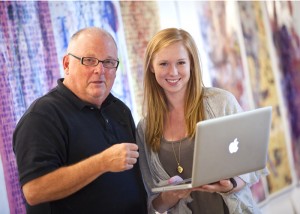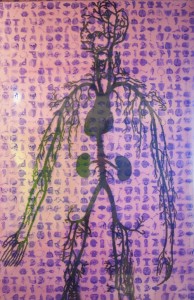 Studying art at Lafayette is a lot like training for a triathlon, where not only do you have to run, you also swim and bike, and physical talent isn’t enough to guarantee a finish. Both your head and heart have to be in the game if you truly want to soar.
Studying art at Lafayette is a lot like training for a triathlon, where not only do you have to run, you also swim and bike, and physical talent isn’t enough to guarantee a finish. Both your head and heart have to be in the game if you truly want to soar.
Take for example an ongoing research project at Lafayette where students mix art and computer science with biology and neuroscience to create images of shared experience layered on transparent sheets.
“Separate, the layers are simple,” says Imogen Cain ’12, an art major from Perkasie, Pa. “But when we put them together they express something else.”
Watch the Emergent Patterns video.
The project is headed by Ed Kerns, Eugene H. Clapp II ’36 Professor of Art, Chun Wai Liew, associate professor and head of computer science, and Elaine Reynolds, associate professor of biology and chair of neuroscience. It combines computational methodology, theories of visual perception, and models of consciousness itself. Students with very different talents and interests are given the opportunity to collaborate in new ways.
 Here’s how it works. Using a software program developed by a team of computer science students, generations of images are produced and printed on transparent materials. Conversations among students and faculty advance the imagery to a final stage when they are then combined into a large-scale work. Frequently, the results are startling and the similarities between the patterns in nature – large and small — are revealed.
Here’s how it works. Using a software program developed by a team of computer science students, generations of images are produced and printed on transparent materials. Conversations among students and faculty advance the imagery to a final stage when they are then combined into a large-scale work. Frequently, the results are startling and the similarities between the patterns in nature – large and small — are revealed.
“Last summer we did a lot of embryos, birds, and snakes,” says Cain, who worked with Ashutosh Tamrakar ’12 , Margaret Bruno-Metzger ’11, and Alex Serowoky ’12 to create the images. “This summer we did more with fish, sharks, and the brain.”
At first you don’t know what you’re seeing, says Serowoky of Dearbon, Mich., who has signed up to undertake an art honors thesis with Kerns as well. “You have to get closer and take a more intimate look. Then you start seeing the images and how things are related,” she says.
Tamraker, who is from Nepal and double majoring in chemical & bimolecular engineering and art, also plans to complete an honors thesis in art with Kerns this year. He says he came to Lafayette so he could combine art with engineering.
 “Learning one definitely makes you appreciate the other,” he says. “It was really cool to apply both of my passions to this project.”
“Learning one definitely makes you appreciate the other,” he says. “It was really cool to apply both of my passions to this project.”
The pieces have an energy, elegance, and wit that embody Lafayette’s philosophy and approach to visual arts.
“We’re one of those programs and schools that think outside the box,” says Serowoky.
Cain agrees. “Drawing on other subjects, like computers and science, really opens your mind to new possibilities, ”says Cain, who was one of two students chosen to participate in an art show at a local college last year. The piece she exhibited layered artwork painted by her 2 ½-year-old brother with acetate photos of them at the zoo. Then she created a video of her brother’s ultrasound photos that was projected on a plaster cast of a pregnant belly.
Art at Lafayette doesn’t take place just on campus.
Led by Kerns, Cain and others are working with artists, residents, and local officials in New Orleans’ Lower Ninth Ward to convert a former public school into a cultural arts center. Cain has traveled twice to New Orleans to take photos and video of the building for a brochure that will be used to help the local residents realize this important community project.
“The Lower Ninth Ward is very artsy,” she says. “That’s their culture. It’s like a different country. You walk through the French Quarter and everywhere you look people are selling their art.”
Cain, who works as Kerns’ studio assistant, says she chose Lafayette because she wanted to study art in a broader context.
“I love it here,” she says. “It’s a small enough campus that you’re not competing with so many people for the same opportunities and you get to build close relationships with your professors. I can’t imagine myself anywhere else.”


